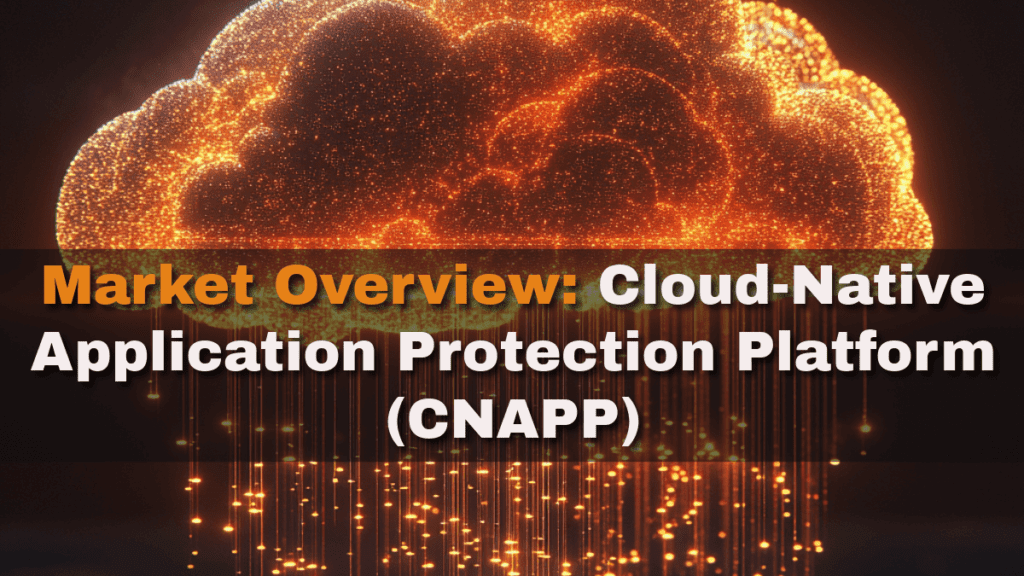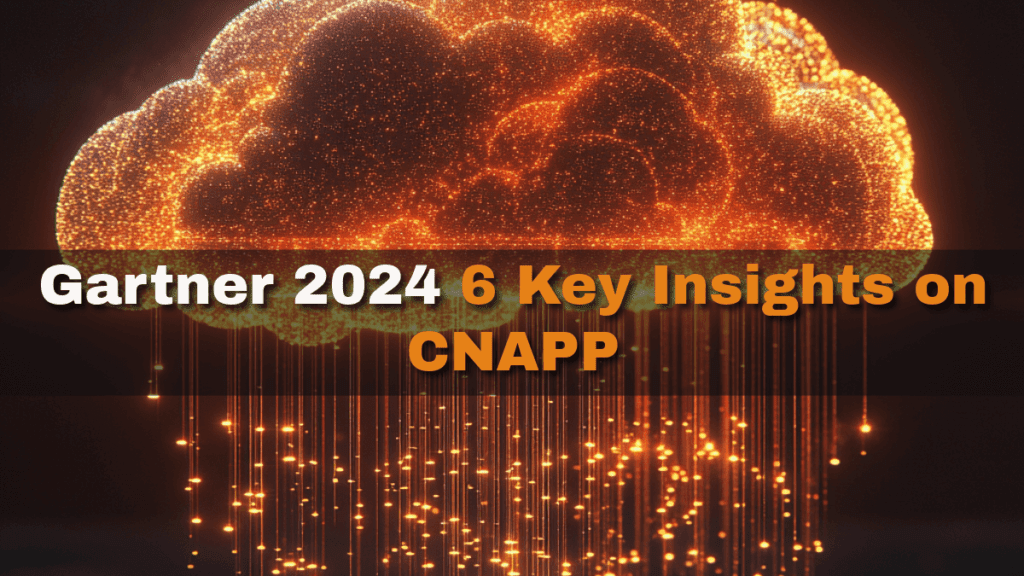🌐 Market Overview: Cloud-Native Application Protection Platform (CNAPP)
Cloud-Native Application Protection Platforms (CNAPPs) are comprehensive solutions that integrate multiple security and compliance capabilities to safeguard cloud-native applications across their entire lifecycle. These capabilities typically include Cloud Security Posture Management (CSPM), Cloud Workload Protection Platforms (CWPP), Application Security Posture Management (ASPM), Infrastructure as Code (IaC) scanning, Cloud Infrastructure Entitlement Management (CIEM), and increasingly, Data Security Posture Management (DSPM).
According to Gartner, by 2029,
60% of enterprises that do not deploy a unified CNAPP will lack adequate visibility into their cloud attack surfaces, thereby undermining their zero-trust security objectives .
This projection underscores the critical importance of adopting integrated CNAPP solutions to achieve comprehensive cloud security.

The CNAPP market is propelled by several key factors:
Expanding Cloud Attack Surfaces: The rapid adoption of cloud services has led to a proliferation of potential vulnerabilities, including misconfigurations, software supply chain threats, and identity and access management challenges.
Shift in Security Responsibilities: Security responsibilities are increasingly shifting towards developers and cloud architects, necessitating tools that integrate seamlessly into development workflows and provide security insights throughout the application lifecycle.
Need for Tool Consolidation: Organizations are seeking to rationalize siloed security tools to reduce costs, complexity, and operational overhead, favoring unified platforms that offer comprehensive visibility and control.
A significant emphasis in the 2024 Gartner Market Guide is the necessity for CNAPPs to provide runtime insights as a core capability. This involves continuous monitoring of live cloud environments to detect and respond to threats in real time, moving beyond traditional pre-deployment scanning approaches.

Top CNAPP Market Guide, Forecast and Gartner Insights on the Leaders
Prisma Cloud (Palo Alto Networks)
Prisma Cloud is named a Leader in the Forrester Wave™: Cloud Workload Security, Q1 2024, for its strong execution, strategy, and Code-to-Cloud coverage. It delivers CSPM, CWPP, CIEM, IaC scanning, container runtime protection, and detection & response—all in one platform—with an AI-powered copilot to prioritize vulnerabilities and streamline remediation. Customers praise its large user community, robust roadmap, and high ROI (264% over 3 years per a commissioned TEI study).
Wiz
Wiz is recognized on G2 as a Leader and by Gartner as a emerging CNAPP vendor. It offers agentless-first scanning, unified risk graph, CSPM, CWPP, IaC scanning, vulnerability management, and CIEM, all with a strong developer-centric UX and contextual prioritization. Wiz emphasizes graph-based attack-path analysis and shift-left security to connect risks from production back to code.
Orca Security
Orca Security is a Strong Performer in the 2024 Forrester Wave™: Cloud Workload Security, Q1 2024, earning top scores in IAM policy optimization, IaC scanning, scale, roadmap, and partner ecosystem. Its agentless-first platform provides 100% asset coverage, Cloud-to-Dev risk context, AI-driven prioritization, and unified data modeling across AWS, Azure, GCP, and Kubernetes.
Microsoft Defender for Cloud
Microsoft Defender for Cloud is rated among the top CNAPPs on G2, lauded for hybrid/multi-cloud visibility, automated compliance, and deep integration with Azure, AWS, and GCP. It combines CSPM, CWPP, CIEM, and regulatory-framework reporting into the broader Microsoft security ecosystem, enabling seamless policy enforcement and threat remediation.
Check Point CloudGuard
Check Point CloudGuard appears in G2’s top-10 CNAPP list for its threat prevention, security management, and network-level controls. It delivers CSPM, CWPP, CIEM, and in-line network-security enforcement with an intuitive interface, plus managed threat-intelligence feeds.
Lacework FortiCNAPP
Lacework’s FortiCNAPP (by Fortinet) is a unified, data-driven CNAPP offered in Standard, Professional, and Enterprise tiers. It covers SCA, SAST, IaC security, SBOM generation, vulnerability assessment, CSPM, threat detection, CIEM, and file integrity monitoring. It leverages both agentless and agent-based telemetry, Polygraph anomaly detection, and attack-path visualization for comprehensive code-to-cloud security.
Xcitium CNAPP Overview
Xcitium CNAPP delivers Zero Trust security, continuous monitoring, and real-time mitigation for cloud-native threats across multi-cloud and hybrid environments. Its modules include ASPM (SAST, DAST, SCA, IaC scanning), CSPM (agentless compliance monitoring), CWPP (behavior modeling, network segmentation, inline policy enforcement), GRC, and Kubernetes Identity & Entitlement Management (KIEM). It also integrates Managed EDR, MDR, and XDR, providing end-to-end threat detection & response.
Cloud-Native Application Protection Platform Market Features & Capability Comparisons
| Capability | Prisma Cloud | Wiz | Orca Security | Defender for Cloud | CloudGuard | Lacework FortiCNAPP | Xcitium |
|---|---|---|---|---|---|---|---|
| CSPM | Yes | Yes | Yes | Yes | Yes | Yes | Yes |
| CWPP | Yes | Yes | Yes | Yes | Yes | Yes | Yes |
| CIEM/KIEM | Yes | Yes | Yes | Yes | Yes | Yes | Yes (KIEM) |
| ASPM (SAST/DAST/SCA/IaC) | Yes | Yes | Yes | Yes | No | Yes | Yes |
| DSPM (Data Security Posture) | Yes | Planned | No | No | No | No | No |
| Agentless-first | No (agent-based & agentless) | Yes | Yes | No | No | Yes | Yes |
| Runtime protection & mitigation | Yes | Yes | No | Yes | Yes | Yes | Yes |
| Graph-based attack-path analysis | No | Yes | No | No | No | Yes | No |
| Compliance automation & reporting | Yes | Yes | Yes | Yes | Yes | Yes | Yes |
| AI-driven prioritization | Yes | Yes | Yes | No | No | Yes | No |
| DevSecOps toolchain integration | Yes | Yes | Yes | Yes | Yes | Yes | Yes |
| Zero Trust network segmentation | No | No | No | No | Yes | No | Yes |

Gartner 2024 6 Key Insights on CNAPP
Here are the 6 key takeaways from the 2024 Gartner CNAPP Market Guide, distilled from expert sources (CrowdStrike, Sysdig, and Uptycs) and vendor commentary:
🧠 1. Runtime Insights Are Now Essential
Gartner elevated runtime visibility and threat detection to a core CNAPP capability. You can’t just scan code pre-deployment anymore—you must monitor live environments continuously.
Sysdig’s view: “You can’t secure what you can’t see.” Runtime provides ground truth.
CrowdStrike’s note: Threats move fast, and runtime gives detection and real-time response capability.
Xcitium advantage: Uses kernel-level virtualization and containment, not just detection, enabling deterministic mitigation in real time—no dwell time.
🧩 2. Unification Across the Cloud Security Lifecycle Is Mandatory
CNAPP must now cover the entire application lifecycle—from code to cloud to workload runtime.
Gartner’s mandate: Tools must unify CSPM, CWPP, CIEM, KSPM, and DSPM.
Uptycs’ insight: Customers are overwhelmed by tool sprawl; unification is not a luxury—it’s a survival need.
Xcitium advantage: Default Deny platform architecture already unifies endpoint, cloud, and app protection without bolt-on tools.
⚙️ 3. Contextual Risk Prioritization Beats Static Policies
Gartner notes that modern CNAPPs must prioritize threats based on identity access graphs, network exposure, data sensitivity, and attack path modeling.
CrowdStrike’s take: Threat prioritization must move from static scoring to real risk context.
Uptycs: You need to show how an attacker could move laterally, not just what config is wrong.
Xcitium response: Their deterministic enforcement bypasses the complexity of modeling graphs—no lateral movement possible inside the virtualized layer.
🔐 4. Identity and Entitlement Are Core to Cloud Security
Gartner highlights that IAM misconfigurations are one of the most exploited vectors in cloud breaches.
Sysdig and Uptycs: Say identity-based attacks will dominate, and Cloud Infrastructure Entitlement Management (CIEM) must be embedded in CNAPPs.
Xcitium approach: IAM visibility is supported, but with kernel isolation, identity breaches are rendered ineffective—apps can’t reach unauthorized resources.
📊 5. Data Security Posture Management (DSPM) Is Now a CNAPP Pillar
Gartner elevated DSPM into CNAPP. It’s not enough to lock down infra—you must discover and protect sensitive data across services.
CrowdStrike: Proactively finds data and flags overexposed or misclassified information.
Uptycs: Adds DSPM with compliance and classification modules.
Xcitium model: Their containment-first model prevents data egress before DSPM is even needed.
⚡ 6. Speed of Response & Risk Reduction Are Top Criteria
Vendors must prove that their CNAPP reduces dwell time, speeds mean time to respond (MTTR), and cuts off kill chains fast.
Sysdig: Emphasizes reducing alert fatigue and getting fewer, higher-quality insights.
CrowdStrike: Focuses on automation and containment within seconds.
Xcitium breakthrough: Kernel API Virtualization provides instant, deterministic isolation, eliminating the chase-and-respond model entirely.
Vendor Claims vs. Xcitium Reality
| Capability | Gartner Emphasis | Common Vendor Approach | Xcitium Advantage |
|---|---|---|---|
| Runtime Insight | Core pillar in 2024 | Agent-based detection | Kernel-level containment & visibility |
| Unified CNAPP | Mandatory | CSPM + CWPP integration | Single virtualized platform |
| Risk Prioritization | Context-aware attack paths | AI-driven graphs & scoring | Default Deny eliminates attack paths |
| Identity Protection | IAM is key | CIEM overlays & policies | Isolation blocks identity abuse |
| DSPM | Now core CNAPP | Tagging, scanning, encryption | Virtualization prevents data exposure |
| Speed & Risk Reduction | MTTR & dwell time focus | EDR-style reaction loop | Pre-emptive isolation – no dwell time |
Direct Gartner 6-Key Takeaways in 2024 – Vendors Head to Head
Below is a consolidated view of how each leading CNAPP vendor aligns to Gartner’s six 2024 key takeaways. In summary:
Every vendor now offers runtime insights—but only Xcitium and Orca deliver deterministic, near‑zero‑dwell containment at the kernel level, rather than detection‑first react-and-kill workflows.
Unification (CSPM, CWPP, ASPM, CIEM, DSPM) is table stakes: all platforms bundle these modules, though Xcitium does so via a single virtualization plane rather than stitched‑together point tools.
Contextual risk prioritization is addressed with AI/ML graphs everywhere—Wiz and Lacework lead with rich security graphs, while Xcitium sidesteps complexity via deterministic policy enforcement.
Identity & entitlement management (CIEM/KIEM) is embedded in all: Microsoft and Check Point provide ML‑driven least‑privilege suggestions, Xcitium offers Kubernetes‑native entitlement controls.
DSPM is maturing: Wiz and Microsoft have full DSPM modules, Prisma and Check Point include data scanning, while Xcitium relies on containment to make DSPM optional.
Speed of response varies: Xcitium and Orca block threats inline in under a minute; others depend on agent/eBPF detection loops and automated remediation workflows.
CNAPP Cloud Infrastructure Market Analysis
| Vendor | 1. Runtime Insights | 2. Unified Lifecycle | 3. Contextual Risk Prioritization | 4. Identity & Entitlement | 5. DSPM | 6. Speed of Response |
|---|---|---|---|---|---|---|
| Prisma Cloud Palo Alto Networks | Agent‑based runtime protection with behavior baselining and real‑time threat prevention | Single platform integrating CSPM, CWPP, CIEM, ASPM, IaC scanning and DSPM | AI/ML‑driven attack‑path graph and risk scoring for prioritized remediation | Built‑in CIEM for least‑privilege enforcement and entitlement visualization | DSPM to discover/classify sensitive data and monitor data posture | Real‑time detection and inline prevention with continuum of controls |
| Wiz wiz.io | eBPF‑based runtime sensor with continuous monitoring and automated remediation | Holistic code‑to‑runtime CNAPP combining posture, workload, identity, data and pipeline security | Security Graph correlates identity, network, workload and data context for risk ranking | Integrated CIEM with data‑access governance and entitlement risk detection | Native DSPM offering for continuous data discovery, classification, and risk assessment | Inline blocking via runtime sensor, achieving near‑zero dwell time |
| Orca Security | Agentless eBPF‑based Orca Sensor for runtime visibility and prevention | SideScanning™ unified platform covering CSPM, CWPP, CIEM and runtime protection | Unified risk graph holistically prioritizes alerts across vulnerabilities, config, identity and runtime | Agentless CIEM via unified data model for effective permission analysis | SideScanning covers basic data risk detection; advanced DSPM via partner modules | Real‑time protection with automatic process kill and alerting |
| Microsoft Defender for Cloud | eBPF‑enhanced sensors and Azure Arc extend runtime detection across VMs, containers, serverless | End‑to‑end CNAPP across DevOps pipelines, CSPM, CWPP, CIEM, DSPM in Azure portal | AI‑powered posture management with attack‑path analysis in paid CSPM plan | Native CIEM with ML‑driven least‑privilege recommendations | Built‑in DSPM discovers and continuously classifies sensitive data | Automated remediation playbooks reduce MTTR and dwell time |
| Check Point CloudGuard | Runtime protection daemon + kernel filters for real‑time threat detection & block | Unified & modular CNAPP with SAST, CSPM, DSPM, CIEM, CWPP, WAF and CDR | Effective Risk Management engine correlates posture, vulnerabilities, entitlements for prioritized remediation | CIEM with ML‑based least‑privilege role enforcement and entitlement logging | DSPM via integrated data scanning modules for sensitive data exposure detection | Real‑time enforcement with one‑click remediation and policy enforcement |
| Lacework FortiCNAPP | Runtime App Self‑Protection (RASP) & anomaly detection for continuous runtime defense | Single AI‑driven platform unifying CSPM, CWPP, CIEM, DSPM, APIsec, SAST, SCA | Polygraph attack‑path analysis correlates config, activity and runtime data | CIEM via continuous entitlement scanning and least‑privilege suggestions | Integrated DSPM with SBOM and PII/PCI classification for data risk visibility | Automated threat detection reduces alert noise by 95%, accelerates triage |
| Xcitium CNAPP | Kernel‑level API virtualization for deterministic, real‑time containment with zero dwell time | Core virtualization sandbox unifies CSPM, CWPP, ASPM, CIEM and GRC without bolt‑ons | Deterministic policy enforcement yields no false alerts—only actionable blocks | Kubernetes Identity & Entitlement Management (KIEM) for least‑privilege enforcement | DSPM optional—containment prevents data exfiltration before classification needed | Inline kernel sandbox blocks threats <1 s, eliminating chase‑and‑respond overhead |
This comparison makes clear that while all CNAPPs now tick Gartner’s boxes, Xcitium’s kernel‑virtualization delivers the most deterministic runtime defense, Orca’s agentless SideScanning offers unmatched visibility, and Wiz’s Security Graph and Lacework’s Polygraph provide the richest contextual prioritization.
Cloud Security CNAPP Market is Highly Competitive
Xcitium CNAPP delivers a robust, Zero Trust-centric platform that aligns on essential CNAPP capabilities and excels at real-time mitigation and Kubernetes entitlement management. However, organizations needing advanced DSPM, AI-driven risk graphs, or agentless-only entitlement management may prefer offerings from Prisma Cloud, Wiz, or Lacework. Ultimately, Xcitium is a strong choice for teams prioritizing inline Zero Trust enforcement and integrated EDR/MDR/XDR, while the market leaders offer broader data-security and AI-centric analytics for more complex multi-cloud deployments.





